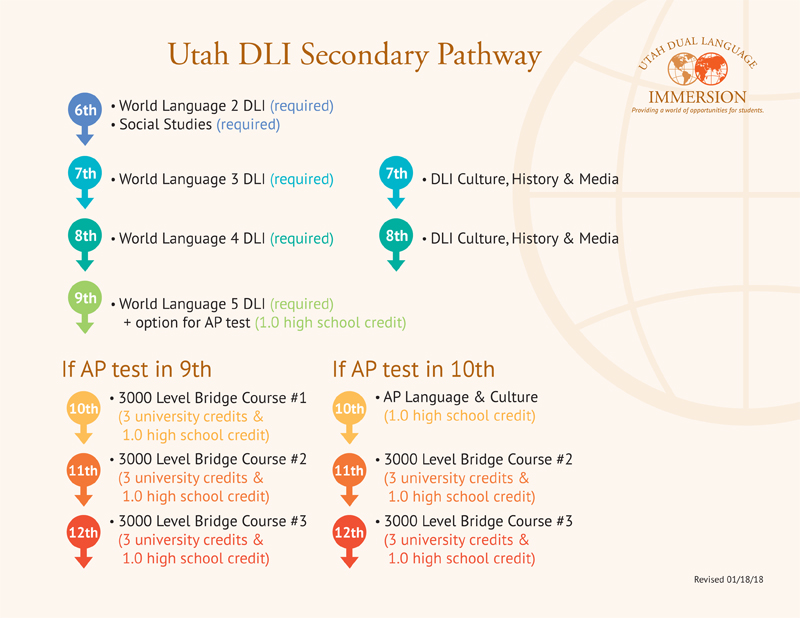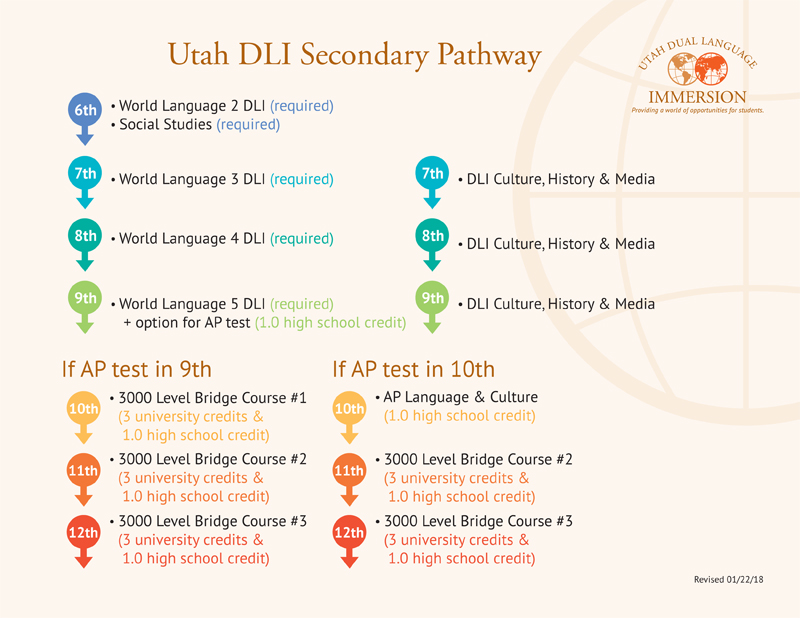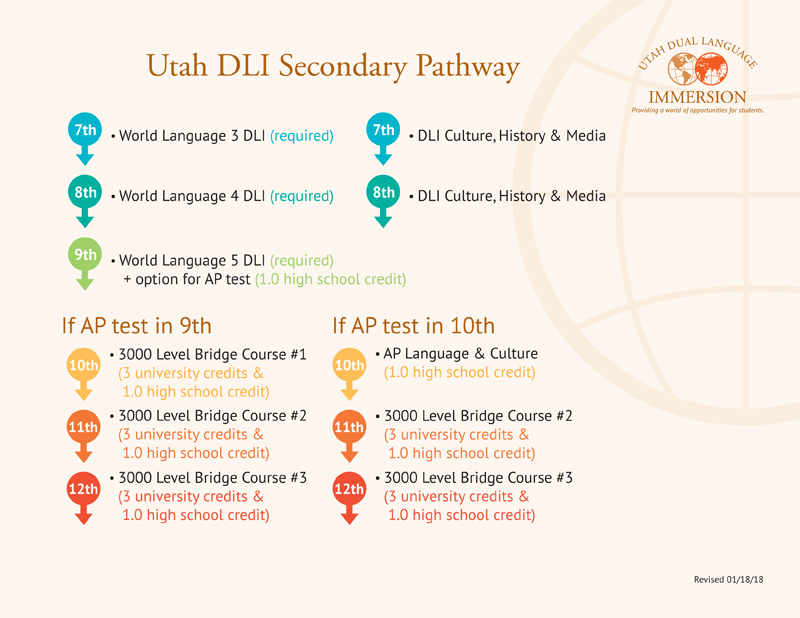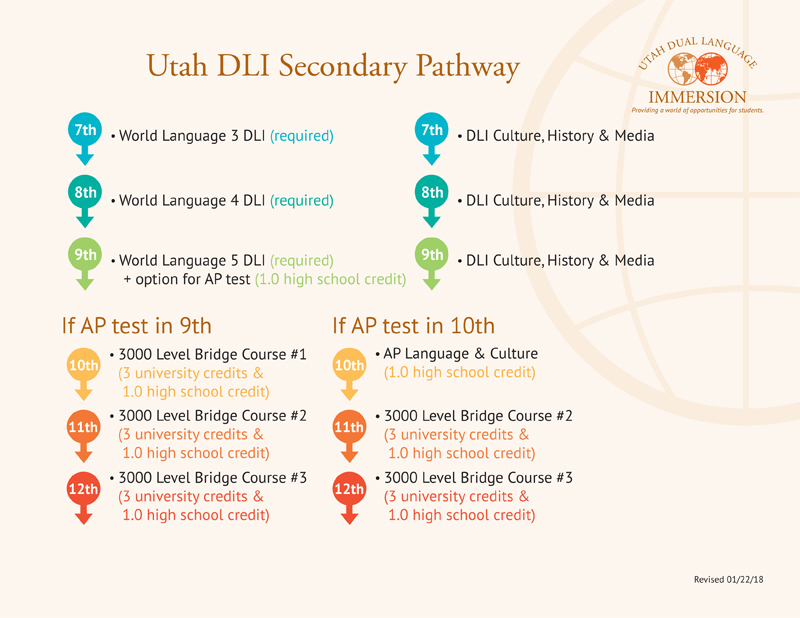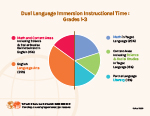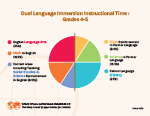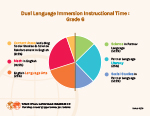 INSTRUCTIONAL MODEL
INSTRUCTIONAL MODEL
The Utah State Dual Language Immersion Elementary Model follows a 50:50 model design where the instructional day in grades K-6 is divided between two high-quality classrooms, each for fifty percent of the instructional time. In this fifty-fifty model, students spend half of their school day in the immersion language and the other half-day in English. All state-sponsored programs are required to use two teachers, one who instructs exclusively in the immersion language for half of the day and a second teacher who teaches exclusively in English the other half of the day.
The elementary program is cohesively articulated into the middle and high school levels, providing students with a K-12th grade immersion experience that already has connections to a university language pathway through the high school Bridge program.

Assessment of the students’ proficiency trajectory is closely monitored in grades K-12 through a comprehensive assessment plan (see plan) that includes both formative and summative tools. In grades K-8, a formative tool named the Student’s Proficiency Report (see sample) is used throughout the year to collect classroom-based performance data by the teacher. In the spring parent-teacher conference each year, the Student Proficiency Report, reflecting the students’ competencies in listening, speaking, reading and writing is shared with parents and students. The Proficiency Report, which provides descriptors of what the student is able to do with language in the classroom environment, provides very concrete evidence of the students’ progress in acquiring the immersion language. In grades 3-8 the ACTFL Assessment of Performance toward Proficiency in Languages (AAPPL) is administered every Fall as a summative performance measure. In 9th grade, the students have the opportunity to take the College Board Advanced Placement (AP) Test. Students who pass the AP test can access the university concurrent courses in 10th-12th grades, known as the Bridge Program for Advanced Language Learning.

Furthermore, to ensure that students are acquiring the content knowledge and skills delineated by the State’s core standards, each district administers reading and math criterion-based measures multiple times during each year. In addition, the State content test (RISE), which evaluates reading, math and science, is administered yearly in late spring. These systemic and thorough data analyses are used to design supports for students as well as to provide feedback for the purpose of program evaluation.
Utah’s Dual Language Immersion curriculum is developed around the five goals of the World Readiness Standards for Language Learning: communication, culture, connection, comparisons and communities. These goals are embedded across the curriculum and provide an explicit framework for the design of the immersion language literacy curriculum.
The immersion program is a proficiency-based language program driven by grade-level language proficiency targets (proficiency targets chart) based on the Proficiency Guidelines as defined in the American Council on the Teaching of Foreign Languages (ACTFL). These grade level proficiency targets provide a clear description of what students can do with language at each level (K-9) in listening, speaking, reading and writing.
Instructional content is the medium for teaching the immersion partner language. The immersion partner language is the medium for learning content. The DLI curriculum is the same curriculum that is taught to non-immersion students throughout the State, except for the addition of explicit instruction in the immersion language. The DLI curriculum reflects the same scope and rigor of the content standards taught in each respective grade level across the State. The allocation of content taught through the immersion language is grade-level dependent as shown on the DLI Instructional Time Pie Charts.
From first through third grade, the immersion language curriculum includes instruction in literacy and the majority of the content subjects (Math, Science, and Social Studies). The English curriculum focuses on English Language Arts and reinforcement of the academic vocabulary and practical application of concepts taught through the immersion language.
The immersion language curriculum shifts in the fourth and fifth grades, as most conceptual instruction in math and social studies take place in English. Academic vocabulary and practical application of concepts taught in English are reinforced in the immersion language. In addition, explicit immersion literacy and science are taught through the immersion language. The elementary math, science and social studies curriculum is organized around the State content standards. Whereas, the literacy curriculum is organized around thematic units. These thematic units in the immersion languages are aligned to the grade-level proficiency targets. Daily language objectives for communication guide the instruction at the appropriate level. A variety of performance tasks are embedded in each thematic unit to offer students multiple contexts to broaden their scope for practicing language skills across the interpretative, interpersonal and presentational modes, in an effort to move them forward on the proficiency trajectory.
The proficiency trajectory is further supported through the middle and high school DLI program articulation, providing students the opportunity to culminate their DLI education in achieving an Advanced-Mid proficiency level in the immersion language and graduate from high school with nine upper division university credits in the immersion partner language.
The Secondary Pathway Charts provide a clear representation of the middle and high school DLI program articulation. In sixth grade, students participate in their immersion partner language DLI course, as well as a Social Studies course taught in their immersion partner language. In 7th and 8th grade, students continue with their DLI immersion partner language courses, and take an additional elective course: Culture, History and Media. This course supports the cultural comparison requirements of the AP exam. The curriculum is scaffolded at each level to ensure students are supported throughout the program to achieve the targeted grade level proficiency.
